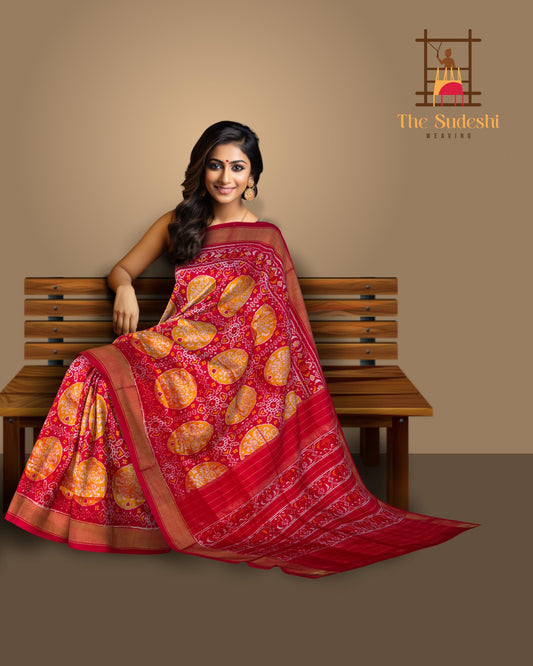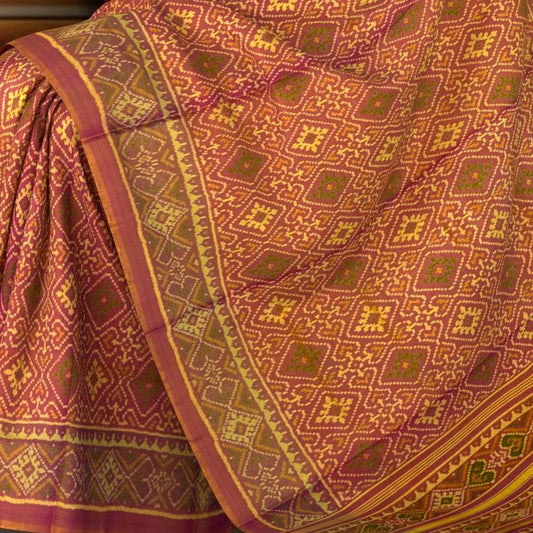The Timeless Bond Between Bharatanatyam and Kanjivaram Silk Sarees: A Symphony of Tradition and Elegance
In the heart of South Indian culture, two symbols stand out as enduring emblems of tradition and grace—Bharatanatyam and Kanjivaram silk sarees. Both are steeped in centuries-old heritage, celebrated not only for their beauty but also for their profound cultural significance. This blog explores the intricate relationship between Bharatanatyam, a classical dance form, and the iconic Kanjivaram silk saree, unraveling how these two have woven together to create a legacy that continues to inspire and captivate the world.
Bharatanatyam: The Dance of Divine Grace
Bharatanatyam is one of the oldest classical dance forms in India, originating from Tamil Nadu. It is known for its fixed upper torso, bent legs, intricate footwork, expressive hand gestures, and striking facial expressions. This dance form is not just a performance art; it's a deeply spiritual practice that narrates stories of devotion, mythology, and human emotions.
The essence of Bharatanatyam lies in its ability to convey complex narratives through dance. Each movement, expression, and gesture is meticulously crafted to reflect the stories of Hindu deities, making it a form of storytelling that transcends time. The dancer becomes a conduit for divine energy, with every performance being a blend of Nritta (pure dance), Nritya (expressive dance), and Natya (dramatic dance).
The Allure of Kanjivaram Silk Sarees
Kanjivaram silk sarees, named after the town of Kanchipuram in Tamil Nadu, are celebrated for their rich texture, vibrant colors, and exquisite craftsmanship. Woven from pure mulberry silk, these sarees are known for their durability and grandeur, often adorned with intricate patterns inspired by nature, mythology, and temple architecture.
The making of a Kanjivaram saree is an art in itself, requiring master weavers to spend anywhere from 10 days to several months on a single piece. The sarees are distinguished by their contrasting borders and pallus (the loose end of the saree), which are often woven with pure gold or silver threads, making them a prized possession in any Indian wardrobe.
Kanjivaram sarees are not just garments; they are a statement of culture and tradition. Each saree tells a story of the weaver’s skill, the cultural heritage of Tamil Nadu, and the timeless elegance of Indian womanhood. They are often passed down through generations, serving as heirlooms that carry the essence of familial love and tradition.
The Perfect Symbiosis: Bharatanatyam and Kanjivaram Silk Sarees
The connection between Bharatanatyam and Kanjivaram silk sarees is profound, rooted in a shared cultural heritage. The saree is more than just attire for a Bharatanatyam dancer; it is an integral part of the performance, enhancing the visual appeal and cultural authenticity of the dance.
1. Symbolism and Aesthetics:
In Bharatanatyam, every element of the dancer’s costume is symbolic. The Kanjivaram saree, with its rich colors and intricate designs, complements the dancer’s movements, highlighting the grace and poise required for the performance. The vibrant hues of the saree contrast beautifully with the dancer's jewelry and makeup, creating a visually stunning spectacle.
2. Tradition and Authenticity:
Wearing a Kanjivaram saree during a Bharatanatyam performance is not just about aesthetics; it’s about maintaining the authenticity of the art form. The saree’s traditional drape accentuates the dancer's posture, making each pose more pronounced and the storytelling more impactful. This adherence to tradition ensures that the essence of Bharatanatyam remains untouched, preserving its purity for future generations.
3. Craftsmanship and Elegance:
Just as Bharatanatyam is a dance of precision and grace, the Kanjivaram saree is a product of meticulous craftsmanship. The attention to detail in both the dance and the saree is remarkable. The pleats of the saree are carefully arranged to allow freedom of movement while maintaining the garment's elegance, making it a perfect fit for the dynamic and expressive nature of Bharatanatyam.
The Role of Kanjivaram Sarees in Bharatanatyam Performances
1. Enhancing the Dance Narrative:
The colors and patterns of the Kanjivaram saree often align with the theme of the Bharatanatyam performance. For instance, a dance portraying the goddess Durga might be performed in a red and gold saree, symbolizing power and divinity. This thoughtful coordination between the saree and the dance narrative adds another layer of meaning to the performance, making it more immersive for the audience.
2. Cultural Continuity:
The use of Kanjivaram sarees in Bharatanatyam is a practice that has been passed down through generations. Dancers often choose sarees that have been handed down by their mothers or grandmothers, thus continuing a cultural legacy that is deeply personal and collective. This tradition not only honors the past but also ensures that the cultural significance of both Bharatanatyam and Kanjivaram sarees is kept alive.
3. A Symbol of Empowerment:
In modern times, the Kanjivaram saree has also become a symbol of empowerment for female Bharatanatyam dancers. The saree, with its rich history and association with femininity, allows dancers to embrace their heritage with pride. Wearing a Kanjivaram saree on stage is a powerful statement of identity, connecting the dancer with her roots while showcasing her art to the world.
Glossary/Support Center
To help you better understand the nuances of Bharatanatyam and Kanjivaram silk sarees, here’s a glossary of some key terms:
- Nritta: Pure dance movements in Bharatanatyam, focusing on rhythm and technique rather than storytelling.
- Nritya: Expressive dance in Bharatanatyam that conveys emotions and narratives.
- Natya: The dramatic aspect of Bharatanatyam, combining dance and theater.
- Pallu: The loose end of a saree, often elaborately decorated, which is draped over the shoulder.
- Zari: Metallic thread used in weaving Kanjivaram sarees, typically made of gold or silver.
- Mudra: Hand gestures in Bharatanatyam used to convey specific meanings and emotions.
- Arangetram: The debut performance of a Bharatanatyam dancer, marking the culmination of their training.
- Temple Borders: A common motif in Kanjivaram sarees, inspired by the architecture of South Indian temples.
Conclusion
The relationship between Bharatanatyam and Kanjivaram silk sarees is a beautiful symbiosis of art, culture, and tradition. Together, they create a visual and spiritual experience that transcends mere performance, embodying the timeless values of grace, devotion, and artistry. As Bharatanatyam dancers continue to don Kanjivaram sarees, they uphold a legacy that is as vibrant and enduring as the silk threads that weave these magnificent garments.
Whether you're a connoisseur of classical dance, a lover of traditional Indian textiles, or someone simply intrigued by cultural heritage, the story of Bharatanatyam and Kanjivaram silk sarees is a testament to the richness of South Indian traditions—a story that continues to unfold with every graceful step and every intricate weave.







Leave a comment
Please note, comments need to be approved before they are published.